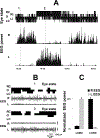Unihemispheric slow wave sleep and the state of the eyes in a white whale
- PMID: 11809503
- PMCID: PMC8788623
- DOI: 10.1016/s0166-4328(01)00346-1
Unihemispheric slow wave sleep and the state of the eyes in a white whale
Abstract
We recorded electroencephalogram (EEG) and simultaneously documented the state of both eyelids during sleep and wakefulness in a sub-adult male white whale over a 4-day-period. We showed that the white whale was the fifth species of Cetaceans, which exhibits unihemispheric slow wave sleep. We found that the eye contralateral to the sleeping hemisphere in this whale was usually closed (right eye, 52% of the total sleep time in the contralateral hemisphere; left eye, 40%) or in an intermediate state (31 and 46%, respectively) while the ipsilateral eye was typically open (89 and 80%). Episodes of bilateral eye closure in this whale occupied less than 2% of the observation time and were usually recorded during waking (49% of the bilateral eye closure time) or low amplitude sleep (48%) and rarely in high amplitude sleep (3%). In spite of the evident overall relationship between the sleeping hemisphere and eye state, EEG and eye position in this whale could be independent over short time periods (less than 1 min). Therefore, eye state alone may not accurately reflect sleep state in Cetaceans. Our data support the idea that unihemispheric sleep allows Cetaceans to monitor the environment.
Figures


References
-
- Castellini MA. Sleep in aquatic mammals. In: Carley D, Radulovacki M, editors. Animal Models of Sleep Related Breathing Disorder. Lung Biology in Health and Disease. New York: Marcel Dekker, 2001, in press.
-
- Goley PG. Behavioral aspects of sleep in pacific white-sided dolphins (Lagenorhynchus obliquidens, Gill 1866). Mar Mamm Sci 1999;15:1054–64.
-
- Lilly JC. Animals in aquatic environments: adaptation of mammals to the ocean. In: Dill DB, Adolph EF, Wilber CG, editors. Handbook of Physiology—Adaptation to the Environment. Washington, DC: American Physiology Society, 1964:741–7.
-
- Lyamin OI, Chetyrbok IS. Unilateral EEG activation during sleep in the cape fur seal, Arctocephalus pusillus. Neurosci Lett 1992;143:263–6. - PubMed
Publication types
MeSH terms
Grants and funding
LinkOut - more resources
Full Text Sources
Other Literature Sources

